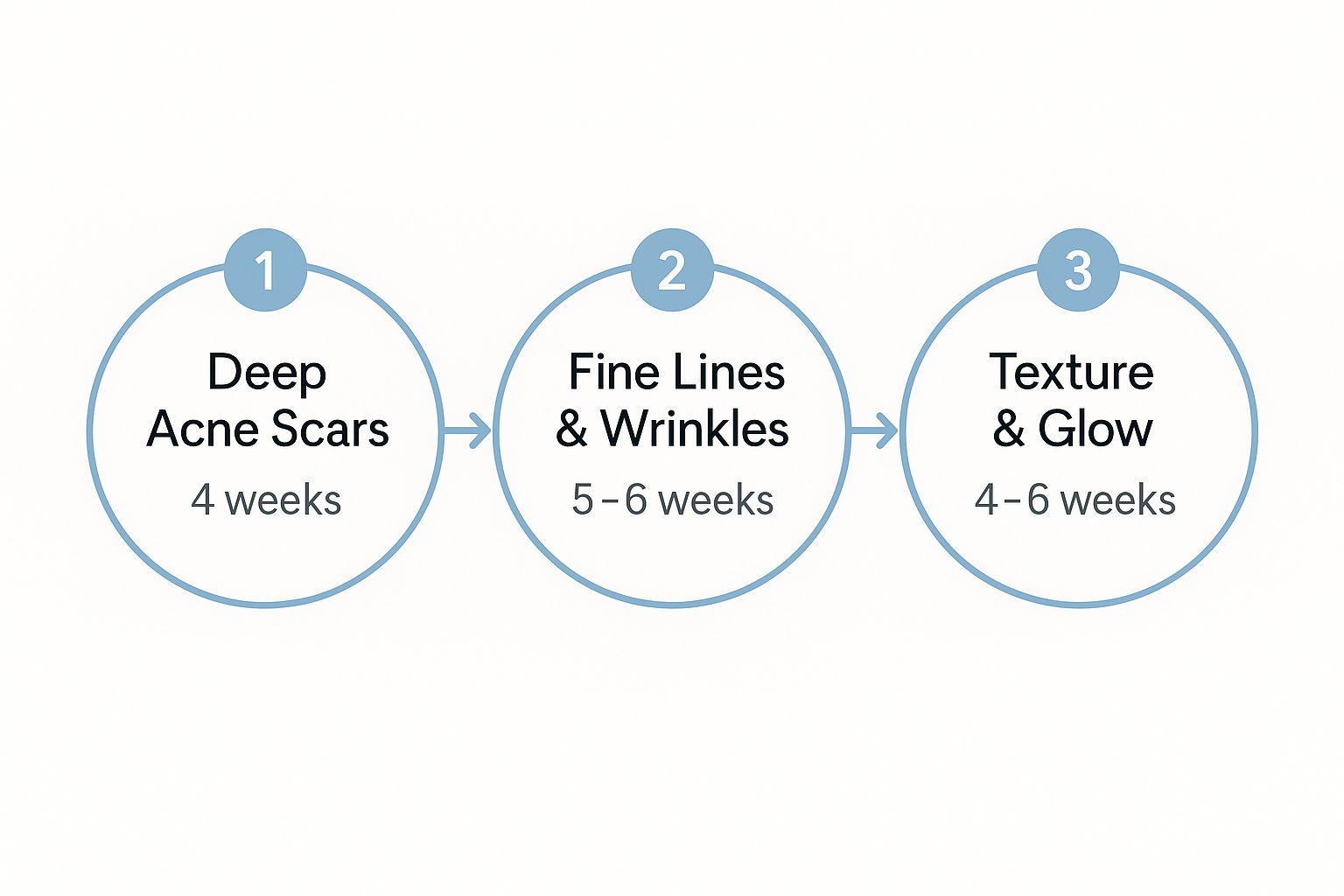
How Often Should Micro Needling Be Done? Your Guide
When it comes to professional microneedling, the sweet spot for most people is scheduling a session every 4 to 6 weeks. This isn't just a random number; it's timed perfectly with your skin's natural life cycle. Think of it as working with your body's own rhythm for healing and renewal.
This gap gives your skin the downtime it needs to rebuild collagen and elastin after a treatment, which is where the real magic happens.
Finding the Right Microneedling Rhythm for Your Skin
Microneedling is a lot like a workout plan for your skin. You wouldn't hit the gym for an intense session every single day, and the same logic applies here. Your skin needs time to rest, recover, and repair itself to get stronger.
That 4 to 6-week break is the crucial recovery phase. It allows the skin to respond to the controlled micro-injuries by generating that firm, youthful collagen we're all after. Pushing it too soon can backfire, leading to irritation instead of rejuvenation.
Of course, the best schedule really boils down to your specific skin goals. Tackling deep-seated scar tissue requires a different approach than softening fine lines on the surface.
Timelines for Common Skin Concerns
While your provider will create a plan just for you, there are some general timelines that can help set your expectations. Most people start with an initial series of treatments to get the ball rolling before moving to a maintenance phase to keep up the results. Each session builds on the last, progressively improving your skin's texture and tone.
- Deep Acne Scars: This usually calls for a more concentrated effort. The goal is to methodically break down stubborn scar tissue and encourage fresh, new skin to take its place.
- Fine Lines & Wrinkles: The focus here is on a steady, cumulative buildup of new collagen and elastin to plump the skin from within.
- General Texture & Radiance: For an overall boost, the aim is to kickstart cell turnover, refine pores, and bring back a healthy glow.
This infographic breaks down the typical frequency for these common goals.

As you can see, more serious concerns like deep scars often benefit from a consistent 4-week schedule, while anti-aging and general rejuvenation can be spaced a little further apart.
Here's a quick summary table to help you visualize the typical treatment plans.
Microneedling Frequency At a Glance
| Skin Concern | Initial Treatment Frequency | Recommended Sessions | Maintenance Schedule |
|---|---|---|---|
| Fine Lines & Anti-Aging | Every 4-6 weeks | 3-4 sessions | Every 6-12 months |
| Acne Scars & Scarring | Every 4 weeks | 4-6 sessions | Every 6 months |
| Hyperpigmentation | Every 4 weeks | 3-5 sessions | Every 4-6 months |
| General Rejuvenation | Every 6 weeks | 3 sessions | Every 12 months |
This table provides a great starting point, but remember that a personalized consultation is the best way to map out a journey that's perfect for your skin's unique needs.
At its core, the principle is simple: professional microneedling treatments are typically scheduled every 4 to 6 weeks. This balances the need for consistent collagen stimulation with the skin's essential healing time. Most clients will start with an initial series of 3 to 6 sessions, spaced accordingly, to achieve their desired results. You can find more expert takes on microneedling timelines from dental and medical aesthetics professionals.
Why the 4 to 6 Week Wait Is So Important
You've probably heard the standard advice: wait 4 to 6 weeks between professional microneedling sessions. This isn't just a random number someone came up with—it's based on the way our skin actually heals and rebuilds itself. Trying to speed things up is a recipe for disappointment, but sticking to this schedule lets the magic happen.
Think of it this way: you can't rush a good thing. Your skin goes through a very specific, three-part process to repair itself after a treatment. Giving it the full 4 to 6 weeks ensures each stage completes its job, setting the foundation for incredible, lasting results.
The Three Phases of Skin Regeneration
From the moment the microneedles create those tiny channels, your skin kicks into a highly organized repair mode. It's a natural process that unfolds over several weeks.
Phase 1: Inflammation (Days 1-3)
This is the immediate "cleanup crew" response. Your body senses the controlled micro-injuries and rushes immune cells to the area. This is why you see some redness and swelling right after your appointment—it’s a sign that the healing cascade has officially begun. It's a healthy, necessary first step.Phase 2: Proliferation (Days 3-21)
Now the real construction begins. For the next three weeks or so, your skin is busy building a new support structure. Fibroblast cells start churning out fresh collagen and elastin, and new blood vessels form to supply the area with nutrients. This is the heavy lifting phase where the framework for smoother, firmer skin is laid down.Phase 3: Remodeling (Day 21 to 1 year)
This is the longest, and arguably most important, stage. The initial, somewhat haphazard collagen (called Type III) gets replaced by a much stronger, more organized form (Type I). This is what truly improves skin texture, fills in acne scars, and softens fine lines. It’s like turning a temporary scaffold into a permanent, reinforced structure. This process continues for months after your treatment.
Jumping into another session too soon is like trying to re-plaster a wall before the first coat has even dried. You’re just disrupting all that delicate, essential work, which can lead to more irritation and completely stall your progress.

Why This Timing Unlocks the Best Results
When you wait the full 4 to 6 weeks, you’re allowing that crucial remodeling phase to get properly started. By the time you come in for your next appointment, your skin is stronger and ready to be stimulated again.
This creates a powerful compounding effect. The collagen from your first session is still maturing and strengthening when you trigger a new wave of production with the second. Each treatment literally builds on the success of the last one.
The 4-6 week interval is the gold standard because it works with your skin's natural regeneration cycle, not against it. It's the strategic sweet spot that lets you build momentum without ever overwhelming your skin's ability to heal.
This is also a key part of understanding how long it takes to see results from microneedling, because the most dramatic improvements don't happen overnight. They appear gradually as your skin completes its rebuilding work. Patience really is a virtue here—respecting this timeline ensures you get the beautiful, rejuvenated skin you’re investing in.
Matching Your Schedule to Your Skin Goals

So, how often should you get microneedling? There’s no magic number. The right schedule really comes down to what you’re trying to achieve with your skin. A plan to tackle deep acne scars is going to look a lot different than one designed just to get that radiant, all-over glow.
Think of it like working out. The frequency and intensity of your gym sessions depend entirely on your goal, whether you're training for a marathon or just trying to stay healthy. Your microneedling schedule is a strategic choice you and your practitioner make together to zero in on your specific concerns. It’s all about applying the right amount of stimulus at the right time to get the best possible results from every single session.
Targeting Deep Acne Scars and Texture
When you're dealing with major texture issues like deep acne scars or pockmarks, you need a more assertive game plan. These concerns live deep down in the dermal layer, where old, disorganized scar tissue has set up shop.
To really break down that stubborn tissue and encourage smooth, healthy skin to take its place, we typically schedule treatments a bit closer together.
- Recommended Frequency: Every 4 weeks.
- Initial Series: Plan on 4 to 6 sessions to start.
- The Rationale: This consistent monthly schedule keeps your skin in a constant state of repair and remodeling. Each session builds on the last, progressively breaking down scar tissue and laying down fresh, organized collagen before the healing process fully wraps up.
For issues like acne scarring, the most effective protocols almost always involve 4 to 6 sessions spaced about a month apart. After that initial series, studies show collagen production can increase by up to 400% six months after the final treatment. That's a huge boost, leading to real, noticeable improvements in skin texture and smoother-looking scars.
Softening Fine Lines and Wrinkles
If you’re focused on anti-aging, the strategy shifts. Instead of aggressive remodeling, the goal is a slow and steady buildup of new collagen. We want to gradually thicken and strengthen the skin's underlying support structure, which helps plump it from the inside out and soften the appearance of fine lines over time.
For this, giving your skin a bit more recovery time between sessions is key. It allows the new collagen from the last treatment to fully mature and strengthen, creating a solid foundation for the next round. Spacing the treatments a little further apart ensures a consistent, sustainable buildup of your skin’s natural scaffolding.
This steady approach is like adding layers of primer before you paint. Each one strengthens the foundation for a flawless final result. It gives the collagen stimulated in the previous session enough time to mature, creating a stronger base for the next treatment to build upon.
Achieving a Radiant Glow and Refining Pores
What if your main goal is just better overall skin tone, smaller-looking pores, and that vibrant, healthy glow? In that case, the schedule can be much more flexible. Here, we're focused on boosting cell turnover and giving a general kickstart to collagen production, rather than performing an intensive overhaul.
An initial series is still a great idea to create a visible shift in your skin's health and appearance.
- Recommended Frequency: Every 4 to 6 weeks.
- Initial Series: Often, 3 sessions are enough to see a significant difference.
This timeline gives your skin a substantial reset, refining its surface and boosting its natural luminosity. You can also amplify your results by incorporating complementary products, like effective peptides to use with microneedling, into your routine. After finishing the initial series, you can switch to a less frequent maintenance plan to keep your skin looking its absolute best.
Professional vs. At-Home Microneedling Frequency

When we talk about how often microneedling should be done, it's crucial to distinguish between a professional treatment and at-home dermarolling. They are worlds apart, and confusing the two isn't just ineffective—it can be downright damaging to your skin.
A professional microneedling session is a clinical procedure designed for real, structural change. We use sterile, medical-grade devices with needles that reach deep into the dermal layer of the skin, typically going 0.5mm and beyond. This depth is what kicks off a true wound-healing response, triggering the production of new collagen and elastin to remodel the skin from the inside out.
I like to use a lawn care analogy. Think of professional microneedling as aerating your lawn. It’s a powerful, periodic treatment that creates deep channels to fundamentally improve the soil structure underneath. You wouldn't do it every day, right? Your lawn—and your skin—needs time to recover. That’s why we always wait 4 to 6 weeks between professional sessions, giving the skin the essential time it needs to heal, regenerate, and get stronger.
The Limits of At-Home Rollers
Now, let's talk about at-home dermarollers. These tools are completely different. Their needles are much shorter, usually less than 0.3mm. They are designed to only interact with the very outermost layer of your skin (the epidermis) and don't come close to the dermis where all the collagen magic happens.
If professional microneedling is aerating, at-home rolling is like lightly raking the surface of your lawn. The goal isn't to rebuild the soil; it's to help your fertilizer sink in a little better. In skincare terms, it’s all about enhancing the absorption of your expensive serums. Because the impact is so superficial, you can do it more frequently, maybe once or twice a week.
Professional microneedling is about rebuilding your skin's foundation. At-home rolling is about enhancing product absorption on the surface. They are not interchangeable, and their frequencies reflect these vastly different goals.
This is a really important distinction. An at-home roller will never give you the kind of results you'd get from a professional session. It simply can't create the controlled micro-injury needed to tackle deeper concerns like acne scars, significant wrinkles, or uneven skin texture. To set realistic expectations and ensure you're treating your skin safely, it helps to understand the full picture of microneedling at home vs. professional treatments.
To make it even clearer, I've put together a quick comparison.
Comparing Professional vs. At-Home Microneedling
This table breaks down the core differences between the two approaches, from the tools used to the results you can expect.
| Feature | Professional Microneedling | At-Home Microneedling (Dermarolling) |
|---|---|---|
| Needle Depth | Deeper (0.5mm - 2.5mm) | Superficial (<0.3mm) |
| Primary Purpose | Collagen induction, scar revision, skin remodeling | Enhanced product absorption |
| Recommended Frequency | Every 4 to 6 weeks | 1-2 times per week |
| Safety Considerations | Low risk in the hands of a trained professional | Higher risk of infection, scarring, and skin damage |
As you can see, the goals and safety profiles are completely different.
In the end, seeking treatment from an experienced professional ensures the procedure is performed safely and at the correct depth for your specific skin concerns. At-home devices, on the other hand, open the door to significant risks if they aren't used and sterilized with absolute precision.
How Your Skin and Lifestyle Shape Your Microneedling Schedule
That standard 4-to-6-week guideline for microneedling? It’s a great starting point, but that's all it is—a start. Think of it less like a strict rule and more like a general recommendation that needs to be tailored specifically to you.
Your skin has its own unique history and biology, so a one-size-fits-all treatment schedule just won't cut it. This is where a personalized consultation becomes so important. A good practitioner will look at your skin, ask about your life, and build a plan that gets you results without pushing your skin too far.
Your Skin Type and Age Are Key Players
Two of the biggest factors that influence your microneedling timeline are your age and your natural skin type. They dictate how resilient your skin is and how quickly it can bounce back after a treatment.
For instance, mature skin naturally has a slower cell turnover. It's just a fact of life. Giving it a little more breathing room between sessions—say, closer to a 6-week interval—allows that crucial collagen and elastin remodeling to finish its job. This way, each new treatment builds on a solid, fully healed foundation.
The same logic applies to anyone with sensitive or reactive skin. A longer pause can be the difference between calm, steady rejuvenation and a state of constant irritation. Pushing sensitive skin too hard and too fast is a recipe for inflammation, not a healthy glow.
The Bottom Line: You have to listen to your skin. A longer interval between treatments isn't a setback. It's a smart, strategic move to make sure you get the absolute most out of every single session without causing unnecessary stress.
Treatment Intensity and Daily Habits
Beyond your skin's built-in tendencies, the way you live your life and the intensity of your treatments play a massive role. The needle depth your provider uses is a perfect example. A deeper treatment designed to break down serious scarring is going to demand a much longer healing window than a light, superficial session aimed at boosting your overall radiance.
Your daily habits can also either help or hinder your skin's recovery.
- Sun Exposure: If you're constantly in the sun without protection, you're not just slowing down the healing process—you're actively breaking down the new collagen you're trying to build. This might mean you need longer breaks between appointments.
- Nutrition and Hydration: A diet packed with vitamins, antioxidants, and water gives your skin the raw materials it needs to repair itself efficiently. On the flip side, poor nutrition can put the brakes on healing.
- Smoking: It's no secret that smoking constricts blood vessels and hampers circulation. This directly impacts your body's ability to heal, which can seriously compromise your microneedling results.
When you get down to it, your skin and your habits call the shots. Someone with thicker, more resilient skin might be ready for another session sooner than someone with delicate, sensitive skin. Factors like sun exposure and stress all have a say in your ideal schedule, which is why a personalized approach is the only way to go. You can find more research on the tolerability of different microneedling treatments on JCAD Online.
An experienced professional will weigh all these variables to map out a timeline that’s perfectly suited to you and your goals.
Planning Your Long-Term Maintenance Sessions
Once you've finished your initial series of treatments, the game changes. You're no longer in a corrective phase; you're now focused on preservation. You've put in the work to get your skin where you want it, and now the goal is to keep it looking fantastic for the long haul.
Think of it like getting in shape. The first few sessions were like an intensive boot camp, designed to kickstart major changes. Maintenance sessions are the regular gym visits that keep you strong and toned. They keep that collagen production cycle humming along, fighting back against the natural aging process.
Finding Your Maintenance Cadence
So, how often should you come back once you're in maintenance mode? For most people, a single professional treatment every 6 to 12 months is the sweet spot. This is just frequent enough to keep the new collagen you've built topped up, ensuring your skin stays firm, smooth, and glowing.
This long-term strategy is all about protecting your investment. It makes sure the improvements you've seen in texture, fine lines, and overall tone don't slowly fade away. Of course, this is just a general guideline. Some people might prefer a touch-up every four months to stay ahead of specific concerns, while others are perfectly happy with one annual session.
The real secret is to listen to your skin. A great maintenance plan isn't a rigid calendar—it's about responding to what your skin needs as time goes on. This is how you sustain beautiful results for years.
When to Schedule Your Touch-Up
Figuring out the perfect time to book that follow-up appointment is a team effort between you and your skincare professional. They can take a look at your skin's health and help you pinpoint the ideal interval to maintain your glow without overdoing it.
There are a few subtle clues that might tell you it's time for a maintenance session:
- Texture Changes: You might notice your skin doesn’t feel quite as silky-smooth as it did a few months after your last treatment.
- Loss of Plumpness: If that firm, bouncy feeling has started to diminish, it’s a good sign it’s time to wake up the collagen again.
- Dullness Creeping In: When your skin's radiance starts to fade, a quick maintenance session can bring back that healthy luminosity.
Ultimately, this phase is all about being proactive. It's far more effective to preserve your results with regular tune-ups than to wait until you feel like you're starting over. To understand the full picture, from start to finish, you can check out our detailed guide on how many microneedling sessions are needed. This forward-thinking approach is what keeps your skin in optimal condition, year after year.
At Olive Skin Therapy, we create personalized microneedling plans that evolve with your skin, from the initial corrective phase to long-term maintenance. Book your consultation today and let's build a strategy to keep your skin healthy and radiant for years to come at https://oliveskintherapy.com.
